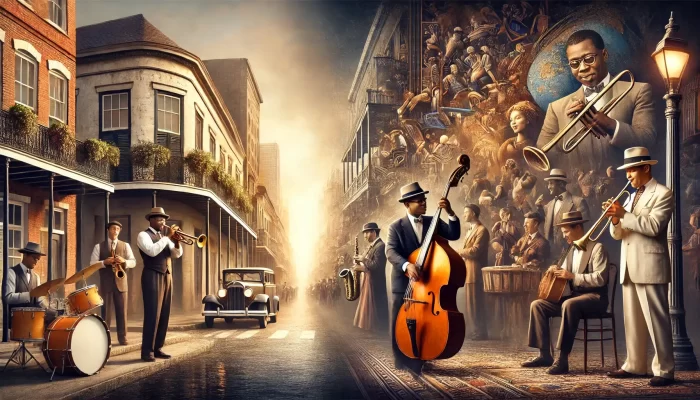Jazz is one of the most influential musical genres in the world. Born in the cultural melting pot of the United States, jazz is a genre defined by improvisation, expression, and innovation. Its rhythms have traveled across continents, shaped other genres, and become a symbol of freedom and creativity. But where did jazz truly begin, and how did it become the global force it is today?
The Birthplace of Jazz: New Orleans
Most music historians agree that New Orleans, Louisiana is the birthplace of jazz. In the late 19th and early 20th centuries, this vibrant port city was home to a diverse mix of cultures — French, Spanish, African, Caribbean, and American. It was in this unique environment that jazz was born.
Jazz evolved from a combination of ragtime, blues, marching band music, and spirituals. It grew out of African-American communities who blended their traditional rhythms with European harmonies, creating a sound that was fresh, spontaneous, and deeply rooted in emotion.
Key Elements That Define Jazz
Jazz is not defined by one sound, but rather by its core elements, including:
- Improvisation: Musicians often make up solos or melodies on the spot
- Swing rhythm: A unique groove that gives jazz its laid-back yet energetic feel
- Syncopation: Rhythmic surprises that challenge traditional timing
- Call and response: A dialogue between instruments or performers
- Blue notes: Notes that bend pitch, adding emotional depth
These features make every jazz performance a living, breathing moment of creation.
The Early Legends: Armstrong, Ellington, and More
In the 1910s and 20s, jazz exploded into popularity, especially during the Jazz Age of the Roaring Twenties. One of its first and biggest stars was Louis Armstrong, a trumpet player and singer whose expressive style and dazzling improvisation set new standards for musicianship.
Duke Ellington, another key figure, expanded jazz’s possibilities by incorporating orchestral arrangements and sophisticated harmonies in his big band compositions. Other pioneers include:
- Jelly Roll Morton – claimed to have invented jazz
- Bessie Smith – a powerhouse blues vocalist with deep jazz roots
- Sidney Bechet – a clarinetist and saxophonist known for his emotional solos
The Harlem Renaissance and the Cultural Boom
In the 1920s and 30s, jazz became an essential part of the Harlem Renaissance, a cultural and artistic explosion among African Americans in New York City. Jazz clubs like the Cotton Club became legendary venues where Black musicians performed to mixed audiences, helping break racial barriers — even in a segregated America.
This period also marked jazz’s spread across the country and into other parts of the world. American soldiers and immigrants brought jazz with them, and soon it could be heard in Europe, South America, and beyond.
Bebop and the Art of Complexity
In the 1940s, a new style of jazz emerged: bebop. This was not music for dancing — it was music for listening, filled with fast tempos, complex harmonies, and intricate solos.
Bebop demanded technical skill and creativity, moving jazz from dance halls to intimate clubs and concert halls.
Jazz and Civil Rights
During the 1950s and 60s, jazz musicians were not just performers — they became activists. Artists like John Coltrane, Charles Mingus, and Max Roach used their music to protest racial injustice and speak to the African-American experience.
Albums like Coltrane’s “Alabama” (inspired by the 1963 church bombing) and Mingus’s “Fables of Faubus” (a critique of segregationist politicians) reflected the turbulent times and gave voice to a movement.
Jazz became a symbol of both artistic freedom and social struggle.
Global Expansion and Fusion
As jazz spread across the world, it merged with local musical traditions:
- Latin Jazz in Cuba and Brazil blended jazz with Afro-Cuban rhythms and bossa nova
- Gypsy Jazz in Europe, led by Django Reinhardt, fused jazz with Romani styles
- Jazz-Rock Fusion in the U.S., with artists like Miles Davis, mixed electric instruments and rock energy with jazz improvisation
Today, you’ll find jazz festivals in Tokyo, Paris, Cape Town, and beyond — a testament to how far the genre has traveled and evolved.
Modern Jazz: Tradition Meets Innovation
Contemporary jazz artists continue to push boundaries while honoring the past. Musicians like Esperanza Spalding, Kamasi Washington, Robert Glasper, and Snarky Puppy are blending jazz with hip hop, R&B, funk, and electronic music.
Jazz education has also grown, with universities offering degrees in jazz performance and theory. What was once an outsider’s art form is now studied, celebrated, and preserved around the world.
Why Jazz Still Matters
Jazz is more than a genre — it’s a philosophy. It encourages listening, reacting, and expressing oneself freely. In a world filled with noise, jazz offers a space for spontaneity and soul.
Whether in a smoky New York club or a sunny festival in Europe, jazz remains a music of the moment — always changing, always alive.

